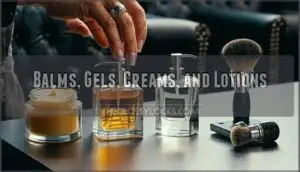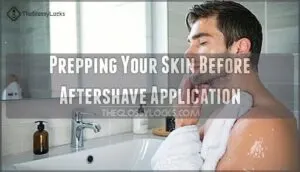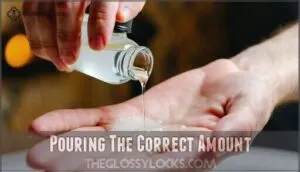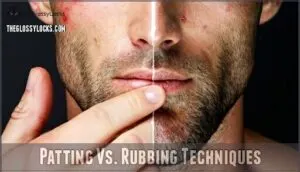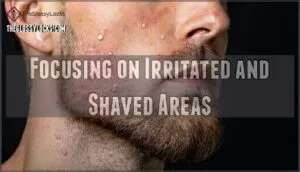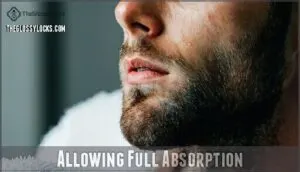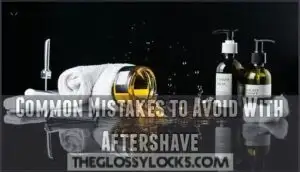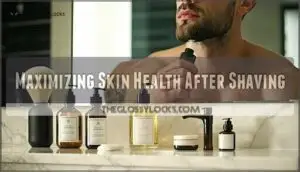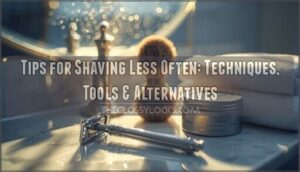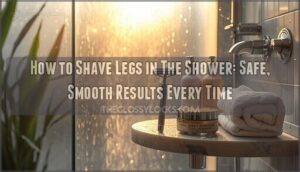This site is supported by our readers. We may earn a commission, at no cost to you, if you purchase through links.

Focus on freshly shaved areas like your neck and jawline where irritation usually strikes hardest. Allow 2-3 minutes for complete absorption before layering other products.
This technique maximizes aftershave’s antiseptic benefits while preventing the stinging sensation that sends many guys running. Proper application transforms aftershave from a necessary evil into your skin’s best ally.
Table Of Contents
Key Takeaways
- Use the right amount – A dime-sized portion on your fingertips prevents burning and waste while ensuring proper absorption into freshly shaved skin.
- Apply to damp, clean skin – Rinse thoroughly after shaving and pat dry before application, as damp skin dramatically improves product absorption and effectiveness.
- Pat, don’t rub – Gentle patting motions prevent further irritation to sensitive post-shave skin, while aggressive rubbing can worsen razor burn and disrupt healing.
- Target problem areas – Focus application on your neck, jawline, and other freshly shaved zones where irritation strikes hardest, then allow 2-3 minutes for complete absorption before adding other products.
What is Aftershave and Why Use It?
Aftershave is a skincare product designed to soothe and protect your skin immediately after shaving. It contains antiseptic ingredients that reduce infection risk by up to 53% while calming irritation.
Beyond just preventing razor burn, quality aftershave moisturizes freshly shaved skin and creates a protective barrier that helps your skin recover faster from the daily trauma of blade contact.
Purpose of Aftershave
Think of aftershave as your skin’s first aid kit after the battlefield of shaving—it’s not just about smelling good, but about healing and protecting the microscopic cuts and irritation that every razor leaves behind. The aftershave benefits go beyond mere scent enhancement, delivering real skin protection when you need it most.
Here’s what quality aftershave does for your skin:
- Infection Prevention – Antiseptic ingredients kill bacteria lurking in tiny nicks
- Irritation Relief – Soothes razor burn and calms inflamed skin immediately
- Hydration Boost – Prevents post-shave dryness that leaves skin tight and uncomfortable
- Skin Protection – Creates a barrier against environmental damage throughout your day
- Scent Enhancement – Adds a subtle fragrance that won’t overpower your cologne
That’s why smart guys don’t skip this step—your skin deserves better than raw vulnerability after shaving.
Key Ingredients and Benefits
Three main ingredient categories drive aftershave benefits: antiseptic ingredients like ethanol (found in 60% of formulations) prevent infection, soothing agents such as aloe vera and witch hazel reduce skin irritation, and moisturizing components like glycerin restore your skin’s protective barrier after shaving. Natural aftershaves often incorporate moisturizing shea butter for its skin benefits.
| Ingredient Type | Key Examples | Primary Benefits |
|---|---|---|
| Antiseptic Ingredients | Ethanol, Isopropyl Alcohol | Reduce infection risk by 28%, cleanse cuts |
| Soothing Agents | Aloe Vera, Witch Hazel, Tea Tree | Calm irritation, tighten pores naturally |
| Moisturizing Components | Glycerin, Vitamin E, Hyaluronic Acid | Restore hydration, improve skin barrier |
These days, companies have to list every ingredient on their labels—no more mystery formulas. People are also moving away from alcohol-heavy aftershaves, looking for gentler options that won’t sting or dry out their skin.
You’ll still find synthetic preservatives like phenoxyethanol keeping products safe on the shelf, but natural formulations are really taking off. They’re growing about 18% each year as more guys want something that soothes rather than burns.
Choosing The Right Aftershave for Your Skin
Your skin type determines which aftershave will work best for you, and picking the wrong formula can leave you with irritation instead of relief.
Understanding the difference between alcohol-based splashes, soothing balms, lightweight gels, and nourishing creams helps you match the right product to your specific needs.
Alcohol-Based Vs. Alcohol-Free Options
Alcohol-based aftershaves deliver proven antiseptic ingredients that reduce infection risk by 53%, but they can trigger skin irritation in sensitive users. Clinical studies even suggest that alcohol is less drying than soap.
More people are switching to gentler options these days. About 63% now go for alcohol-free aftershaves with witch hazel and soothing botanicals instead.
It really comes down to your skin type. If you have normal skin that doesn’t get easily irritated, alcohol-based aftershaves work great and give you that proven antiseptic protection.
But if you’re someone who deals with redness or sensitivity, you’ll probably be happier with the gentler alcohol-free options.
Balms, Gels, Creams, and Lotions
Once you’ve sorted through the alcohol question, you’ll find yourself staring at a wall of different textures that can make your head spin faster than a barbershop pole. Each formula brings distinct postshave care benefits:
- Aftershave balm delivers deep moisturizing with rich emollients for sensitive skin
- Gels offer lightweight gel absorption without greasy residue
- Creams provide intensive cream hydration for dry, irritated areas
Understanding these texture differences helps you match lotion usage to your skin’s specific needs after shaving.
Prepping Your Skin Before Aftershave Application
Think of prepping your skin like setting the foundation for a house—get it right, and everything else falls into place perfectly.
Clean, damp skin isn’t just recommended for aftershave application, it’s the difference between soothing relief and wasted product that sits on the surface doing nothing.
Cleansing and Rinsing After Shaving
Think of your freshly shaved face like a freshly painted wall—you wouldn’t slap on another coat without cleaning up the mess first.
Rinse thoroughly with lukewarm water temperature to remove shaving cream residue and loose whiskers. Gentle cleansers work best for this postshave care step, avoiding harsh scrubbing that could worsen razor burn.
Pat dry with a clean towel—never rub—to prevent irritating your freshly shaved skin before moving to the next important step in your shaving routine.
Importance of Damp Skin
Think of aftershave on damp skin like spreading butter on warm toast instead of cold, dry bread. When your skin’s still slightly wet, it soaks up the product way better.
Damp skin absorbs aftershave like warm toast soaks up butter, while dry skin just lets it sit on the surface
Your pores are more open after a hot shower or splash of water, so the aftershave actually gets where it needs to go. You’ll get better hydration, less stinging, and real protection against razor burn instead of just sitting on the surface.
Avoiding Common Pre-Application Mistakes
Most guys think they can slap on aftershave like it’s cologne and call it a day, but that approach will leave your skin burning instead of soothed.
Skip these rookie mistakes: don’t apply aftershave to dirty skin still covered in shaving cream residue, and never use it on completely dry skin.
Choose the wrong product for your skin type, and you’re setting yourself up for irritation that negates the whole purpose of your shaving routine.
Step-by-Step: Best Way to Apply Aftershave
Getting your aftershave application right makes all the difference between smooth, comfortable skin and potential irritation.
Here’s the exact process I’ve refined over years behind the chair to help you get the greatest benefits from your post-shave routine.
Pouring The Correct Amount
Less is more with aftershave—a dime-sized amount is all you need to get the job done without turning your face into a stinging mess. Think palm size matters here: pour just enough to cover your fingertips, not your entire palm. Product concentration varies between brands like NIVEA MEN and others, so start small and adjust based on your skin’s response and the aftershave benefits you’re after.
- Your wallet will thank you – using the right amount means your aftershave bottle lasts months longer
- No more burning sensation – avoiding overuse prevents that eye-watering sting that makes you question your shaving routine
- Smoother skin texture – proper application frequency with correct amounts keeps your face feeling soft, not sticky
- Confidence boost – knowing you’ve got the technique down makes every shave feel professional
- Better absorption – your skin actually soaks up the right amount instead of leaving residue on your collar
Patting Vs. Rubbing Techniques
Your skin is like freshly tilled soil after shaving—it needs gentle care, not aggressive handling. This is why the way you apply aftershave can make or break your post-shave experience.
Patting benefits your skin by allowing better absorption rates without disrupting healing tissue. Rubbing drawbacks include increased skin sensitivity and potential irritation to already compromised areas.
Gentle patting technique efficacy preserves your skin’s natural barrier while delivering aftershave’s protective benefits.
Focusing on Irritated and Shaved Areas
Think of aftershave like a targeted medicine—it works best when you apply it exactly where the razor did its work, not everywhere on your face. Focus on irritation hotspots like your neck and jawline, where razor burn commonly strikes hardest.
Here’s where to concentrate your aftershave application:
- Neck area – The most common spot for razor burn and ingrown hairs
- Jawline curves – Where the razor changes direction and creates friction
- Under the chin – Often neglected but prone to nicks and irritation
- Cheek hollows – Where skin stretches during shaving, causing sensitivity
- Upper lip area – Delicate skin that needs gentle pressure and circular massaging
Use circular massaging motions with gentle pressure on these targeted areas. This technique helps the aftershave balm penetrate deeper while promoting better blood flow for faster healing.
Don’t waste product on unshaved areas—your aftershave works harder when it’s concentrated where your skin actually needs the benefits of aftershave‘s soothing properties.
Allowing Full Absorption
Patience isn’t just a virtue here—it’s the difference between aftershave that actually works and product that just sits on your skin’s surface doing nothing. Give your skin 2-3 minutes before layering other products. This complete absorption time lets the antiseptic ingredients do their job while your skin type determines how quickly hydration kicks in.
| Skin Type | Absorption Time | Next Steps |
|---|---|---|
| Oily | 1-2 minutes | Light moisturizer optional |
| Normal | 2-3 minutes | Regular moisturizer if needed |
| Dry | 3-4 minutes | Always follow with moisturizer |
| Sensitive | 2-3 minutes | Gentle, fragrance-free products only |
| Combination | 2-3 minutes | Target different areas accordingly |
During this waiting period, avoid touching your face or applying additional skincare after shaving products. The benefits of aftershave—reduced irritation, better skin care, and protection—only happen when absorption and hydration occur naturally. Rushing this step wastes your investment in quality types of aftershave.
Common Mistakes to Avoid With Aftershave
Even experienced shavers make simple aftershave mistakes that can undo all their careful grooming work.
The most common slip-ups—using too much product, skipping proper skin prep, or choosing the wrong formula—can leave your skin irritated instead of soothed.
Overusing Aftershave
Here’s where many people go wrong—they think more aftershave equals better results, but overdoing it can turn your post-shave routine into a skin disaster.
Too much product creates skin sensitivity and irritation rather than the soothing benefits of aftershave you’re after.
A few drops go further than you’d think, preventing product waste while avoiding scent overload that overwhelms everyone around you.
Applying to Dirty or Dry Skin
Consider this: you wouldn’t pour cologne on a dusty mirror and expect it to shine, yet countless men make this exact mistake with aftershave every morning.
Dirty skin effects include trapped bacteria and debris that prevent proper absorption, while dry skin impact creates irritation aggravation instead of soothing relief.
Clean, damp skin makes your aftershave balm work effectively, not against you.
Using The Wrong Product Type
Choosing the wrong aftershave type for your skin is like wearing winter boots to the beach – it might work, but you’ll be uncomfortable and miss out on the benefits you’re actually looking for.
Men with sensitive skin who grab alcohol-heavy splashes often face increased irritation, while those with dry skin using lightweight lotions miss the deep hydration an aftershave balm provides.
Your skin type determines whether you need NIVEA MEN’s soothing balm or a revitalizing splash.
Maximizing Skin Health After Shaving
Getting your aftershave routine right is just the starting point for healthier skin after shaving.
The real key comes from knowing how to layer your products and choosing gentler alternatives that work with your skin, not against it.
Combining Aftershave With Moisturizers
Most guys think aftershave alone does the heavy lifting, but the real magic happens when you layer it with a good moisturizer.
Wait until your aftershave balm fully absorbs—about thirty seconds—then apply a lightweight lotion with compatible moisturizer ingredients. This application order locks in hydration benefits while preventing product compatibility issues.
For sensitive skin, choose fragrance-free options that won’t clash with your men’s skin care routine.
Preventing Redness and Irritation
Nobody wants to look like they went ten rounds with an angry razor, yet post-shave redness hits even experienced shavers when they least expect it. The key is gentle application pressure and choosing aftershave with soothing ingredients like witch hazel. Here’s how to prevent irritation:
- Use cooling effects – Products like NIVEA MEN aftershave balm contain menthol for immediate relief
- Match your skin type – Sensitive skin needs alcohol-free formulas with calming botanicals
- Perfect your timing – Apply post-shave care while skin’s still damp for greatest absorption
Product Trends and Gentle Alternatives
People are ditching alcohol-based aftershaves in droves. These days, 63% of buyers want alcohol-free options packed with gentler stuff like witch hazel and shea butter.
NIVEA MEN’s sensitive line is crushing it here—they’ve grabbed six of the top balm spots.
Nearly three out of ten aftershaves now pull double duty as moisturizers.
And here’s the thing—guys are actually willing to shell out more cash for brands that use sustainable packaging, as long as the eco-friendly claims check out.
Frequently Asked Questions (FAQs)
Can aftershave expire or go bad?
Like milk in your fridge, aftershave doesn’t last forever. Shelf life generally ranges from 2-5 years, depending on ingredient degradation and storage conditions.
You’ll notice visual changes or scent alteration when it’s time to toss that aftershave balm.
Should you apply aftershave before cologne?
Aftershave always comes first in your grooming routine. Application order matters for scent layering and fragrance longevity.
Apply aftershave to soothe skin, then wait for complete absorption before adding cologne to avoid product compatibility issues and skin sensitivity.
How long should aftershave last on skin?
Everyone expects aftershave to vanish within minutes, but quality products should provide benefits for 2-4 hours after application. Scent longevity depends on product concentration, skin absorption rates, and environmental factors like humidity and temperature.
Here’s what affects aftershave duration:
- Types of aftershave – Balms last longer than splashes due to heavier formulations
- Fragrance concentration – Higher concentrations extend both scent and skin benefits
- Skin absorption varies by individual skin type and moisture levels
- Environmental factors like heat and humidity accelerate evaporation
- Reapplication timing becomes necessary every 3-4 hours for continued benefits
Maximizing fragrance longevity requires proper application to damp skin immediately after shaving, allowing full absorption before adding other products.
Can women use mens aftershave products?
Of course women can use men’s aftershave! The whole "men’s" vs "women’s" thing is just marketing. Your skin doesn’t care what the package looks like.
What matters is whether the ingredients work for you—things like how sensitive your skin is, whether you like the scent, and what your skin actually needs after shaving.
| Factor | Men’s Products | Women’s Considerations |
|---|---|---|
| Ingredient Safety | Alcohol, witch hazel, essential oils | Same ingredients, same safety profile |
| Product Efficacy | Reduces irritation, moisturizes skin | Identical benefits for post-shave care |
| Types of aftershave | Balms, splashes, gels, lotions | All formulations suitable for any user |
| Scent Preferences | Often woody, musky fragrances | Personal choice, not gender-specific |
| Skin care for men | Designed for post-shave needs | Women’s shaving creates identical requirements |
Products like NIVEA MEN aftershave contain the same soothing and protective ingredients that benefit anyone’s skin after shaving. The antiseptic properties, moisturizing elements, and healing compounds don’t discriminate based on gender. Your skin’s reaction depends on sensitivity levels and ingredient compatibility, not whether the package has masculine branding.
Does aftershave help with ingrown hairs?
While your buddy Jake thought aftershave was just for scent, he discovered it’s actually a major benefit for preventing ingrown hairs. Aftershave balm with witch hazel helps prevent ingrown hairs by reducing inflammation and keeping skin hydrated after shaving, making it an essential preventative measure.
Here’s how aftershave helps tackle Ingrown Hair Causes:
- Antiseptic action – Cleansing ingredients in aftershave prevent bacterial infections that worsen ingrown hairs
- Reduced inflammation – Types of aftershave containing witch hazel soothe irritated follicles
- Proper hydration – Benefits of using aftershave include maintaining skin moisture for easier hair growth
The key to Aftershave Effectiveness lies in choosing alcohol-free formulas. Exfoliation Importance can’t be overstated – combine your aftershave routine with gentle exfoliation. Look for Specific Ingredients like witch hazel and chamomile rather than harsh alcohols that dry your skin.
Conclusion
Mastering aftershave application is like learning to play a musical instrument—precision and practice create harmony between product and skin.
The best way to apply aftershave involves using a dime-sized amount on damp skin, patting gently rather than rubbing aggressively. Focus on freshly shaved areas, allow complete absorption, and remember that consistency trumps quantity.
Your skin will thank you with reduced irritation, better healing, and that confident post-shave feeling every time.
- https://www.clinikally.com/blogs/news/aftershave-essentials-enhancing-your-post-shave-experience
- https://www.forbes.com/sites/josephdeacetis/2021/12/22/the-best-aftershaves-for-men-the-ultimate-guide/
- https://www.stratumclinics.com/types-of-aftershave-ingredients-that-can-irritate-acne/
- https://dermatologyofct.com/the-dermatologists-guide-to-healthy-shaving-prepping-shaving-and-choosing-the-right-aftershave/
- https://skintypesolutions.com/blogs/skincare/how-to-choose-the-best-aftershave


